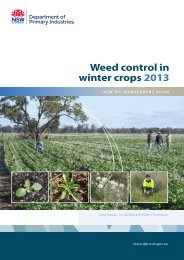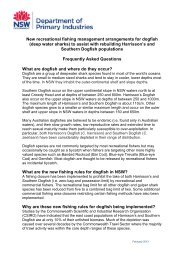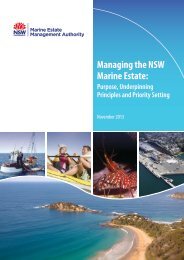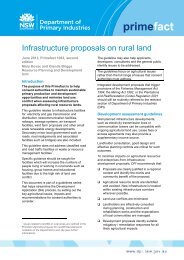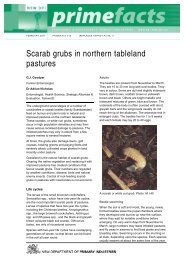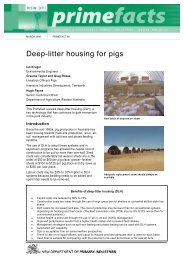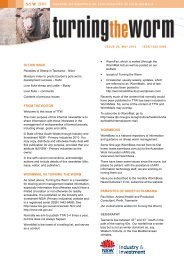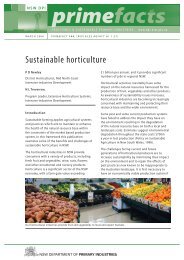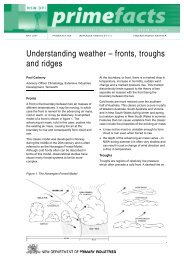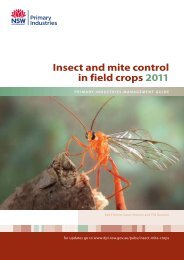Cattle worm control - the basics - NSW Department of Primary ...
Cattle worm control - the basics - NSW Department of Primary ...
Cattle worm control - the basics - NSW Department of Primary ...
Create successful ePaper yourself
Turn your PDF publications into a flip-book with our unique Google optimized e-Paper software.
JUNE 2007 PRIMEFACT 419 (REPLACES AGNOTE DAI-312)<br />
<strong>Cattle</strong> <strong>worm</strong> <strong>control</strong> – <strong>the</strong> <strong>basics</strong><br />
Stephen Love<br />
Veterinarian/State Worm Control Coordinator,<br />
Extensive Industries Development, Armidale<br />
Dr Gareth Hutchinson<br />
Research Officer (Parasitology), Health Science,<br />
Strategic Alliances & Evaluation, Menangle<br />
Abbreviations used<br />
AR: an<strong>the</strong>lmintic resistance<br />
ML: macrocyclic lactones<br />
BZ: benzimidazole<br />
LEV: levamisole<br />
IVM: ivermectin<br />
EPI: eprinomectin<br />
This Primefact outlines <strong>the</strong> <strong>basics</strong> <strong>of</strong> <strong>worm</strong> <strong>control</strong><br />
for grazing beef cattle in New South Wales. The<br />
same general principles apply to dairy cattle,<br />
although <strong>the</strong> details may vary and, in addition, milk<br />
withholding periods <strong>of</strong> an<strong>the</strong>lmintics (especially<br />
flukicides) also need to be considered. The<br />
importance <strong>of</strong> various cattle <strong>worm</strong>s in different<br />
climatic zones is summarised in Table 1.<br />
A brief outline follows.<br />
Round Worms (Nematodes)<br />
Gastrointestinal. The small brown stomach <strong>worm</strong><br />
(Ostertagia ostertagi) is <strong>the</strong> most important<br />
round<strong>worm</strong> <strong>of</strong> cattle in temperate regions<br />
worldwide, including <strong>NSW</strong>. O<strong>the</strong>r gastrointestinal<br />
<strong>worm</strong> species, however, including Haemonchus<br />
placei, Cooperia spp., Trichostrongylus spp.,<br />
Oesophagostomum and Bunostomum (hook<strong>worm</strong>)<br />
add to <strong>the</strong> total impact on host animals.<br />
Lung<strong>worm</strong>s. <strong>Cattle</strong> can be infected with lung<strong>worm</strong>s<br />
(Dictyocaulus viviparus), but <strong>the</strong>se parasites are<br />
usually not a problem in <strong>NSW</strong>.<br />
Flukes (Trematodes)<br />
Liver fluke (Fasciola hepatica) is an important<br />
parasite <strong>of</strong> cattle in certain areas (where conditions<br />
are suitable for <strong>the</strong> intermediate host, an aquatic<br />
snail). ‘Fluky’ areas occur mainly in <strong>the</strong> eastern<br />
third <strong>of</strong> <strong>NSW</strong>, but also in some western irrigation<br />
areas.<br />
Stomach fluke (such as Paramphistomum spp. or<br />
Calicophoron spp.) occasionally cause disease,<br />
mainly in coastal areas. Adult stomach flukes do<br />
little damage; most problems are caused by large<br />
numbers <strong>of</strong> migrating immature flukes in <strong>the</strong> small<br />
intestine.<br />
Table 1. Harmful cattle <strong>worm</strong>s and <strong>the</strong>ir distribution<br />
(Source: Love & Hutchinson 2003, adapted from<br />
Cole 1986)<br />
Common / significant<br />
Summer rainfall areas <strong>of</strong> <strong>NSW</strong><br />
Haemonchus placei<br />
Ostertagia ostertagi (Small brown stomach <strong>worm</strong>)<br />
Cooperia punctata – C. pectinata (Intestinal <strong>worm</strong>), as a<br />
complex, <strong>of</strong>ten with Ostertagia and Bunostomum<br />
phlebotomum (Hook<strong>worm</strong>)<br />
Oesophagostomum radiatum (Nodular <strong>worm</strong>)<br />
Non-seasonal to winter rainfall areas<br />
Ostertagia ostertagi<br />
Trichostrongylus axei (Stomach hair <strong>worm</strong>)<br />
Cooperia oncophora<br />
Occasionally significant, mainly subclinical, or<br />
sometimes present in large numbers<br />
Fasciola hepatica (Liver fluke)<br />
Paramphistomum spp. (Stomach fluke)<br />
Calicophoron calicophorum (Stomach fluke)<br />
Strongyloides spp. (Thread<strong>worm</strong>)
Integrated parasite management (IPM)<br />
Producers should manage <strong>worm</strong>s by using ‘nonchemical’<br />
as well as ‘chemical’ <strong>control</strong> options.<br />
‘Non-chemical’ options include improved nutrition<br />
and providing ‘<strong>worm</strong>-safe’ pastures for young<br />
cattle. Strategies include <strong>the</strong> following.<br />
Immunity and nutrition<br />
Well-fed animals develop immunity faster and are<br />
better able to expel parasites and to withstand <strong>the</strong><br />
effects <strong>of</strong> those that remain.<br />
Young cattle are most susceptible to <strong>worm</strong>s, but<br />
usually develop useful immunity by around 20–24<br />
months. In general, cattle develop better immunity<br />
to <strong>worm</strong>s than sheep and goats. Although adult<br />
cattle <strong>of</strong>ten require little or no drenching for<br />
round<strong>worm</strong>s (as opposed to liver fluke), some<br />
animals can become <strong>worm</strong>y. Susceptible animals<br />
may include bulls, first-calf heifers, and severelystressed<br />
individuals.<br />
Pasture/grazing management<br />
Dung pats can provide shelter for <strong>worm</strong> larvae for<br />
several months, even in very dry conditions.<br />
Therefore, paddocks continually grazed by young<br />
cattle in autumn and winter can become very<br />
<strong>worm</strong>y.<br />
It is important to prepare a number <strong>of</strong> ‘<strong>worm</strong>-safe’<br />
pastures, particularly in higher-rainfall areas <strong>of</strong><br />
<strong>NSW</strong>. This is so young, susceptible cattle can be<br />
moved every few months to paddocks with fewer<br />
<strong>worm</strong> larvae. Aim to graze weaners from early<br />
August through to summer on <strong>the</strong> least<br />
contaminated pastures available.<br />
Begin preparing ‘low-<strong>worm</strong>’ pastures for spring four<br />
months ahead (i.e. in April). The table below shows<br />
different low-<strong>worm</strong> pastures.<br />
Best<br />
Good<br />
High-risk<br />
Drenching<br />
New sown pasture or crop.<br />
Pasture grazed by sheep for previous 4<br />
months.<br />
Pasture not grazed by any cattle for previous<br />
4 months.<br />
Pasture grazed by adult dry cattle or cattle<br />
older than 18 months <strong>of</strong> age.<br />
Pasture grazed by young cattle such as<br />
weaners.<br />
For <strong>the</strong> timing and frequency <strong>of</strong> drenching, see <strong>the</strong><br />
section on ‘Putting it all toge<strong>the</strong>r’.<br />
Round<strong>worm</strong>s<br />
An<strong>the</strong>lmintic treatments may be necessary to<br />
<strong>control</strong> round <strong>worm</strong>s in young cattle, particularly in<br />
higher-rainfall areas (<strong>the</strong> Coast and Tablelands). In<br />
low-rainfall areas <strong>of</strong> western <strong>NSW</strong>, drenching <strong>of</strong><br />
cattle <strong>of</strong> any age is rarely required. (If in doubt,<br />
check young cattle using a <strong>worm</strong> egg count.)<br />
For most <strong>of</strong> <strong>NSW</strong>, regular treatment <strong>of</strong> adult cattle<br />
is not required.<br />
Fluke<br />
On liver fluke-affected farms, treatment <strong>of</strong> all cattle<br />
with a flukicide will be required one or more times a<br />
year, depending on <strong>the</strong> severity <strong>of</strong> <strong>the</strong> problem.<br />
The most important liver fluke treatment is usually<br />
in late autumn (April/May) when both immature and<br />
adult flukes are present. Some flukicides are only<br />
effective against adults. Consider rotating from one<br />
flukicide type to ano<strong>the</strong>r in order to slow <strong>the</strong><br />
development <strong>of</strong> resistance. Warning: flukicides<br />
containing triclabendazole must not be used in<br />
lactating dairy cattle.<br />
Stomach fluke can affect cattle under certain<br />
conditions, particularly in coastal areas.<br />
For more information on stomach and liver fluke,<br />
see <strong>the</strong> relevant Primefacts on <strong>the</strong> <strong>NSW</strong> DPI<br />
website at www.dpi.nsw.gov.au/primefacts .<br />
Drench types<br />
See Table 3<br />
Drench resistance<br />
In an earlier worldwide review <strong>of</strong> AR in cattle<br />
<strong>worm</strong>s, Hutchinson (2003) states that: ‘although<br />
evidence <strong>of</strong> resistance in cattle <strong>worm</strong>s is only<br />
slowly coming to light and has so far been<br />
restricted to <strong>the</strong> less-pathogenic species <strong>of</strong> T. axei<br />
and Cooperia, it should be expected that resistance<br />
to MLs is likely to become established in Australia’.<br />
A more recent international review (Kaplan 2004)<br />
noted that clinical case reports basing bovine<br />
nematode resistance on treatment failures were<br />
insensitive. However, some cattle nematodes were<br />
reported to have proven resistant to BZ and ML in<br />
o<strong>the</strong>r parts <strong>of</strong> <strong>the</strong> world: Haemonchus and<br />
Cooperia in Argentina (Anziani et al 2004); and<br />
Cooperia in Europe (Coles 2002).<br />
In New Zealand <strong>the</strong>re have been reports from <strong>the</strong><br />
early 1990s <strong>of</strong> resistance to BZs principally in<br />
Cooperia but also in Ostertagia and<br />
Trichostrongylus (Hosking & Watson 1991,<br />
McKenna 1996). ML resistance has been reported<br />
more recently, again principally in Cooperia<br />
(Vermunt et al 1996).<br />
With growing concern over <strong>the</strong> apparent level <strong>of</strong><br />
resistance in cattle nematodes, a major systematic<br />
survey to assess <strong>the</strong> situation in beef cattle in NZ<br />
was recently completed (reviewed by Pomeroy<br />
2006), Based on faecal egg count reduction tests<br />
at only 7–10 days after treatment (a possible<br />
weakness in <strong>the</strong> design) it used only oral drenches<br />
PRIMEFACT 419, CATTLE WORM CONTROL – THE BASICS 2
on 62 randomly selected farms in <strong>the</strong> North Island.<br />
The two types <strong>of</strong> system examined were intensive<br />
bull-beef rearing systems (hand reared bull calves<br />
or purchased as weaners 10–12 weeks old) and<br />
‘cow-calf’ where calves were reared on mo<strong>the</strong>rs<br />
until weaning at 28–30 weeks <strong>the</strong>n grown out on<br />
<strong>the</strong> same or separate finishing farms. The study<br />
was restricted to <strong>the</strong> North Island as bull-beef<br />
rearing had only recently been introduced to <strong>the</strong><br />
South Island.<br />
The estimated prevalence <strong>of</strong> IVM resistance in<br />
Cooperia was 92% and 62% for albendazole<br />
(Waghorn et al 2006). Fortunately LEV was still<br />
effective against <strong>the</strong>se resistant strains <strong>of</strong><br />
Cooperia. However, it is normally poorly effective<br />
against inhibited Ostertagia.<br />
Ostertagia in cattle had albendazole resistance with<br />
a prevalence <strong>of</strong> 35% but only 9% <strong>of</strong> farms had IVM<br />
or LEV resistance in this species.<br />
Risk factors for an<strong>the</strong>lmintic resistance were<br />
examined in a concurrent interview and<br />
questionnaire <strong>of</strong> farmers’ opinions and practices<br />
regarding AR on <strong>the</strong>se same farms (Jackson et al<br />
2006). This revealed that <strong>the</strong> median number <strong>of</strong><br />
treatments was five. One in four farms used<br />
an<strong>the</strong>lmintics on calves on 8–12 occasions in <strong>the</strong>ir<br />
first year <strong>of</strong> life (a much higher frequency than<br />
would ever be considered in Australian conditions).<br />
Most an<strong>the</strong>lmintics used for <strong>the</strong> past five years<br />
were ML or <strong>the</strong>ir combinations, ra<strong>the</strong>r than BZ, LEV<br />
or BZ/LEV combinations (Jackson et al 2006).<br />
Why <strong>the</strong>re is ML resistance in Cooperia but not in<br />
Ostertagia in mixed infections when MLs are <strong>the</strong><br />
main drenches used is not explained. Most<br />
farmers, although aware <strong>of</strong> AR, did not perceive it<br />
to be a major problem in cattle. It was concluded<br />
that all cattle farms should now be using<br />
combinations on most occasions to achieve<br />
effective <strong>control</strong> <strong>of</strong> all parasites.<br />
Ano<strong>the</strong>r study (Mason and McKay 2006)<br />
investigated <strong>the</strong> efficacies <strong>of</strong> pour-on an<strong>the</strong>lmintics<br />
on five New Zealand farms with suspected<br />
resistance. The study was against field strains <strong>of</strong><br />
parasitic nematodes in young cattle. Resistance to<br />
IVM and EPI was confirmed in C. oncophora on all<br />
farms. There was limited emergence <strong>of</strong> Ostertagia<br />
resistant to IVM, but not EPI; in o<strong>the</strong>r (short-tailed)<br />
Cooperia species <strong>the</strong>re was resistance to both IVM<br />
and EPI; and in Trichostrongylus <strong>the</strong>re was<br />
resistance to IVM, EPI and LEV used separately. It<br />
was concluded that simultaneous administration <strong>of</strong><br />
LEV and IVM pour-on is likely to <strong>control</strong> both MLresistant<br />
C. oncophora and stages <strong>of</strong> Ostertagia<br />
that are not <strong>control</strong>led by LEV.<br />
On a positive note, <strong>the</strong>re have been no case<br />
reports <strong>of</strong> clinical parasitism in cattle in NZ where<br />
<strong>the</strong> effect <strong>of</strong> resistant nematodes has been<br />
quantified (Jackson et al 2006).<br />
Australia has had only two confirmed cases <strong>of</strong><br />
drench resistance in cattle – both involving BZ<br />
(‘white’) drenches. One case involved oxfendazoleresistant<br />
Trichostrongylus axei (stomach hair <strong>worm</strong>)<br />
in western Victorian cattle (Eagleson and Bowie<br />
1986). The o<strong>the</strong>r was for oxfendazole and febantelresistant<br />
T axei in <strong>the</strong> New England region <strong>of</strong> <strong>NSW</strong><br />
(Eagleson et al. 1992).<br />
Some factors which may increase <strong>the</strong> selection <strong>of</strong><br />
resistant <strong>worm</strong>s include:<br />
• increased exposure <strong>of</strong> <strong>the</strong> <strong>worm</strong> population to<br />
an<strong>the</strong>lmintics (through frequent drenching);<br />
• exposure <strong>of</strong> <strong>worm</strong>s to sub-lethal doses <strong>of</strong><br />
an<strong>the</strong>lmintics (through under-dosing);<br />
• drenching unnecessarily in dry seasons or dry<br />
environments when <strong>the</strong>re are very few <strong>worm</strong><br />
larvae on pasture. (Note, however, that cattle<br />
<strong>worm</strong> larvae can survive for some time in <strong>the</strong><br />
protected conditions <strong>of</strong> a dried dung pat, unlike<br />
in sheep faecal pellets).<br />
In many areas <strong>of</strong> <strong>NSW</strong>, especially drier areas,<br />
cattle are drenched too <strong>of</strong>ten, particularly adult<br />
cattle. (Seek local expert advice on how much<br />
drenching is required). Also, unlike <strong>the</strong> situation in<br />
sheep, <strong>the</strong> three main broad-spectrum families –<br />
BZs, LEV and ML drenches – are still effective on<br />
<strong>the</strong> majority <strong>of</strong> cattle properties. However, many<br />
producers use just one family <strong>of</strong> drenches – rarely,<br />
if ever, rotating.<br />
Quarantine drenching<br />
When introducing cattle from o<strong>the</strong>r properties,<br />
consider ‘cleaning <strong>the</strong>m out’ with a ‘quarantine’<br />
drench, at least for round<strong>worm</strong>s, and possibly also<br />
for liver fluke.<br />
Currently, <strong>the</strong> need for a ‘quarantine’ drench in<br />
cattle is somewhat less than in sheep. An<strong>the</strong>lmintic<br />
resistance is much less common in cattle <strong>worm</strong>s,<br />
so <strong>the</strong> risk <strong>of</strong> importing resistant <strong>worm</strong>s is less.<br />
Also, cattle, especially adult cattle, tend to have far<br />
fewer problems with <strong>worm</strong>s than sheep.<br />
Fine tuning<br />
In consultation with your adviser, fine-tune an<br />
integrated parasite management program to suit<br />
your property. Use WormTest (<strong>worm</strong> egg counts) to<br />
monitor your <strong>worm</strong> <strong>control</strong> program.<br />
<strong>Cattle</strong> (especially adult cattle) can be drenched too<br />
<strong>of</strong>ten. WormTest can help with decisions about<br />
drenching; however, faecal <strong>worm</strong> egg counts can<br />
be an unreliable indicator <strong>of</strong> actual <strong>worm</strong> burdens<br />
in cattle – especially cattle older than 9–12 months.<br />
In yearling or adult cattle that appear to be <strong>worm</strong>y<br />
but have low <strong>worm</strong> egg counts, consider a<br />
‘diagnostic drench’, that is, drenching a small<br />
PRIMEFACT 419, CATTLE WORM CONTROL – THE BASICS 3
number <strong>of</strong> cattle in <strong>the</strong> mob and monitoring <strong>the</strong><br />
response to treatment. Clinical disease or reduced<br />
performance can sometimes be present when egg<br />
counts are very low.<br />
Putting it all toge<strong>the</strong>r<br />
Table 2 (below) gives an example <strong>of</strong> a cattle <strong>worm</strong><br />
<strong>control</strong> program. Remember that cattle in many<br />
areas <strong>of</strong> <strong>NSW</strong> will require fewer treatments than<br />
are included here.<br />
Always read <strong>the</strong> label<br />
Users <strong>of</strong> agricultural (or veterinary) chemical<br />
products must always read <strong>the</strong> label, and any<br />
permit, before using <strong>the</strong> product, and strictly<br />
comply with <strong>the</strong> directions on <strong>the</strong> label and <strong>the</strong><br />
conditions <strong>of</strong> any permit. Users are not absolved<br />
from compliance with <strong>the</strong> directions on <strong>the</strong> label or<br />
<strong>the</strong> conditions <strong>of</strong> <strong>the</strong> permit by reason <strong>of</strong> any<br />
statement made or not made in this publication.<br />
References and fur<strong>the</strong>r information<br />
See related Primefacts on <strong>the</strong> <strong>NSW</strong> <strong>Department</strong> <strong>of</strong><br />
<strong>Primary</strong> Industries website:<br />
www.dpi.nsw.gov.au/primefacts<br />
Anziani OS, Suarez V, Guglielmone AA, Warnke O,<br />
Grande H and Coles GC (2004). Resistance to<br />
benzimidazole and macrocyclic lactone<br />
an<strong>the</strong>lmintics in cattle nematodes in Argentina.<br />
Veterinary Parasitology 122: 58-59<br />
Boray JC (1999). Liver fluke disease in sheep and<br />
cattle. Primefact 446, revised by Dr GW<br />
Hutchinson and Stephen Love (July 2003). <strong>NSW</strong><br />
DPI.<br />
Cole VG (1986). Helminth parasites <strong>of</strong> sheep and<br />
cattle. Animal Health in Australia, Volume 8.<br />
Australian Agricultural Health and Quarantine<br />
Service, <strong>Department</strong> <strong>of</strong> <strong>Primary</strong> Industry, Canberra,<br />
pp. 255<br />
Coles GC. Sustainable use <strong>of</strong> an<strong>the</strong>lmintics in<br />
grazing animals. Veterinary Record 151:165-169.<br />
Eagleson JS and Bowie JY (1986). Oxfendazole<br />
resistance in Trichostrongylus axei in cattle in<br />
Australia. Veterinary Record 119, 604.<br />
Eagleson JS, Bowie JY, and Dawkins HJS (1992).<br />
Benzimidazole resistance in Trichostrongylus axei<br />
in Australia. Veterinary Record 131, 317-318.<br />
Freeman P. Beef cattle on <strong>the</strong> North Coast. Rural<br />
Lands Protection Board, Casino, <strong>NSW</strong>.<br />
Hosking BC and Watson TG (1991).<br />
Benzimidazole- resistant nematodes in cattle.<br />
Journal <strong>of</strong> <strong>the</strong> New Zealand Institute <strong>of</strong> Agricultural<br />
Table 2. An example <strong>of</strong> a beef cattle <strong>worm</strong> <strong>control</strong> program (higher rainfall Tablelands area) 1 .<br />
Date Class <strong>of</strong> stock Management Additional treatments<br />
Young (< 20 months) Adults Liver fluke 3 Stomach fluke 4<br />
Feb<br />
Drench for inhibited<br />
Ostertagia 2 .<br />
April/May Drench at weaning. Begin preparation <strong>of</strong> ‘safe’<br />
Early August<br />
Drench and move to<br />
safe pasture. Move<br />
again later in spring, if<br />
possible.<br />
Regular drenching may not be<br />
required.<br />
pastures for spring 5 .<br />
+<br />
+<br />
+ +<br />
1 This is a guide only. Fewer drenches may be required in many areas. Drenching may rarely be required on <strong>the</strong> Western<br />
Plains. More drenches are generally required in high-rainfall areas with productive pastures, especially if no sheep are grazed<br />
and/or grazing management is not practised.<br />
2 The February drench for round<strong>worm</strong>s – if required – should be highly-effective and aimed at inhibited Ostertagia (small brown<br />
stomach <strong>worm</strong>). MLs are most effective, followed by BZs. Levamisole has limited activity against inhibited Ostertagia.<br />
3 Only treat for liver fluke if its presence is confirmed on your property. Between 1–3 fluke treatments for all ages <strong>of</strong> cattle may<br />
be necessary. The most important <strong>of</strong> <strong>the</strong>se is <strong>the</strong> April treatment, followed by <strong>the</strong> August treatment, <strong>the</strong>n <strong>the</strong> February treatment.<br />
Consider rotating from one flukicide to ano<strong>the</strong>r (unrelated) flukicide. Use a highly-effective flukicide at <strong>the</strong> April treatment.<br />
4 Stomach fluke can be a problem in certain coastal areas. Seek veterinary advice. Treatment <strong>of</strong> all cattle in <strong>the</strong>se localities in<br />
August to reduce pasture contamination may be appropriate.<br />
5 Methods <strong>of</strong> producing ‘safe’; or ‘low-<strong>worm</strong>’ pasture include cropping, hay aftermath, and grazing beforehand with sheep or<br />
adult cattle, or cattle older than 18 months.<br />
PRIMEFACT 419, CATTLE WORM CONTROL – THE BASICS 4
Science 26: 53.<br />
Hutchinson GW (2003). <strong>Cattle</strong> nematodes and<br />
resistance with particular reference to MLs. Turning<br />
<strong>the</strong> Worm Newsletter, Issue 11, May 2003, <strong>NSW</strong><br />
DPI, 4-8. Retrieved 30 January 2007 from<br />
http://www.agric.nsw.gov.au/reader/ttwnews<br />
Jackson R, Rhodes AP, Pomroy WE, Leathwick<br />
DM, West DM, Waghorn TS and M<strong>of</strong>fat JR (2006).<br />
An<strong>the</strong>lmintic resistance and management <strong>of</strong><br />
nematode parasites on beef cattle-rearing farms in<br />
<strong>the</strong> North Island <strong>of</strong> New Zealand. New Zealand<br />
Veterinary Journal 54: 289-296.<br />
Kaplan RM (2004). Drug resistance in nematodes<br />
<strong>of</strong> veterinary importance: a status report. TRENDS<br />
in Parasitology 20:477-481.<br />
Lloyd JB, Boray J and Campbell N (2003).<br />
Identifying liver fluke snails. Primefact 476, <strong>NSW</strong><br />
DPI.<br />
Lloyd JB and Boray J (2003). Stomach fluke<br />
(paramphistomes) in ruminants. Primefact 452,<br />
revised by Stephen Love. <strong>NSW</strong> DPI.<br />
Love SCJ and Hutchinson GW (2003). ‘Pathology<br />
and diagnosis <strong>of</strong> internal parasites in ruminants’.<br />
Gross Pathology <strong>of</strong> Ruminants, Proceedings 350,<br />
9–11 April 2003, Elizabeth Macarthur Agricultural<br />
Institute, Camden, <strong>NSW</strong>, Australia. Post-Graduate<br />
Foundation in Veterinary Science, University <strong>of</strong><br />
Sydney, 309–338.<br />
Mason PC and McKay CH (2006). Field studies<br />
investigating an<strong>the</strong>lmintic resistance in young cattle<br />
on five farms in New Zealand. New Zealand<br />
Veterinary Journal 54: 318-322.<br />
McKenna PB (1996). An<strong>the</strong>lmintic resistance in<br />
cattle nematodes in New Zealand. Is it increasing?<br />
New Zealand Veterinary Journal 44: 76.<br />
Pomroy WE (2006). An<strong>the</strong>lmintic resistance in New<br />
Zealand: A perspective on recent findings and<br />
options for <strong>the</strong> future. New Zealand Veterinary<br />
Journal 54: 265-270.<br />
Smeal MG (1995). ‘Parasites <strong>of</strong> <strong>Cattle</strong>’, Veterinary<br />
Review No.32, The University <strong>of</strong> Sydney, Post-<br />
Graduate Foundation in Veterinary Science, pp.<br />
358.<br />
Spence S (2001). Dung beetles – working for you.<br />
Primefact 442, <strong>NSW</strong> DPI<br />
Vermunt JJ, West DM and Pomroy WE (1996).<br />
Inefficacy <strong>of</strong> moxidectin and doramectin-resistant<br />
Cooperia spp. in New Zealand. New Zealand<br />
Veterinary Journal 44: 188-193.<br />
Waghorn TS, Leathwick DM, Rhodes AP, Jackson<br />
R, Pomroy WE, West DM and M<strong>of</strong>fat JR (2006).<br />
Prevalence <strong>of</strong> an<strong>the</strong>lmintic resistance on 62 beef<br />
cattle farms in <strong>the</strong> North Island <strong>of</strong> New Zealand.<br />
New Zealand Veterinary Journal 54: 278-282.<br />
Acknowledgements<br />
This Primefact was drawn from a variety <strong>of</strong><br />
sources, including research, notes and publications<br />
by:<br />
• Dr Malcolm Smeal, formerly <strong>of</strong> <strong>NSW</strong> Agriculture,<br />
currently with ‘Sou<strong>the</strong>rn Beef Advisory’, Sydney.<br />
• Dr Paul Freeman, <strong>NSW</strong> <strong>Department</strong> <strong>of</strong> <strong>Primary</strong><br />
Industries, formerly District Veterinarian, Casino,<br />
<strong>NSW</strong>.<br />
• Dr Stephen Jagoe, formerly District Veterinarian,<br />
Bega (South Coast), <strong>NSW</strong>.<br />
• Dr Roy Everett, formerly <strong>of</strong> <strong>NSW</strong> Agriculture.<br />
Suggestions and assistance from John Seaman,<br />
Lee Cook, Belinda Walker, John Evers, Shaun<br />
Slattery, Rod Hoare, Malcolm Smeal, and John<br />
Macfarlane are also acknowledged.<br />
© State <strong>of</strong> New South Wales through <strong>NSW</strong> <strong>Department</strong> <strong>of</strong><br />
<strong>Primary</strong> Industries 2007. You may copy, distribute and<br />
o<strong>the</strong>rwise freely deal with this publication for any purpose,<br />
provided that you attribute <strong>NSW</strong> <strong>Department</strong> <strong>of</strong> <strong>Primary</strong><br />
Industries as <strong>the</strong> owner.<br />
ISSN 1832-6668<br />
Replaces Agnote DAI-312<br />
Check for updates <strong>of</strong> this Primefact at:<br />
www.dpi.nsw.gov.au/primefacts<br />
Disclaimer: The information contained in this publication is<br />
based on knowledge and understanding at <strong>the</strong> time <strong>of</strong> writing<br />
(June 2007). However, because <strong>of</strong> advances in knowledge,<br />
users are reminded <strong>of</strong> <strong>the</strong> need to ensure that information<br />
upon which <strong>the</strong>y rely is up to date and to check currency <strong>of</strong><br />
<strong>the</strong> information with <strong>the</strong> appropriate <strong>of</strong>ficer <strong>of</strong> New South<br />
Wales <strong>Department</strong> <strong>of</strong> <strong>Primary</strong> Industries or <strong>the</strong> user’s<br />
independent adviser.<br />
Job number 7298<br />
PRIMEFACT 419, CATTLE WORM CONTROL – THE BASICS 5
Table 3-Registered cattle drenches (an<strong>the</strong>lmintics)<br />
Sources: Infopest, January 2007; Australian Pesticides and Veterinary Medicines Authority (www.apvma.gov.au)<br />
Constituents Product name Company<br />
Broad-spectrum round<strong>worm</strong> drenches – benzimidazoles ('BZ', 'white')<br />
(Check label for efficacy and persistency <strong>of</strong> activity against different <strong>worm</strong> species)<br />
Albendazole (112.5 g/L)<br />
Fenbendazole (100 g/L)<br />
Fenbendazole (25 g/L)<br />
Albendazole <strong>Cattle</strong> Mini-Drench<br />
Nuwhite CC<br />
Strategik Mini-Dose (<strong>Cattle</strong>)<br />
Valbazen Mini-Dose <strong>Cattle</strong><br />
Fenbendazole 100<br />
Fencare 100<br />
Panacur 100<br />
Fenbendazole<br />
Fenbendazole<br />
Fencare 25<br />
Panacur 25<br />
WSD<br />
Captec<br />
Jurox<br />
Pfizer<br />
WSD<br />
Virbac<br />
Intervet<br />
4Farmers<br />
WSD<br />
Virbac<br />
Intervet<br />
Oxfendazole (100 g/L) Worma Drench Farnam<br />
Oxfendazole (45.3 g/L)<br />
Oxfendazole (75 g/L)<br />
Oxfendazole (90.6 g/L)<br />
Combat White An<strong>the</strong>lmintic<br />
Oxazole LV - Sheep, <strong>Cattle</strong> Goats<br />
Oxfen LV<br />
Systamex Oral<br />
Alternate<br />
Bomatak Pour-On<br />
Bomatak.C<br />
Oxazole - <strong>Cattle</strong> & Horses<br />
Oxfen C<br />
Parafend LV<br />
Systamex Concentrated Drench<br />
Virbac<br />
Jurox<br />
Virbac<br />
Coopers<br />
Bomac/Elanco<br />
Bomac<br />
Bomac/Pharm tech<br />
Jurox<br />
Virbac<br />
Norbrook<br />
Coopers<br />
Broad-spectrum round<strong>worm</strong> drenches – levamisole ('LEV', 'clear')<br />
(Check label for efficacy and persistency <strong>of</strong> activity against different <strong>worm</strong> species)<br />
Levamisole (base) (125 g/L) Nilverm Pour-On Coopers<br />
Levamisole (base) (200 g/L)<br />
Levamisole as HCl (27 g/L)<br />
Big-L Pour-On<br />
Citarin Pour-On<br />
Levamisole Pour-On<br />
Levipor<br />
Big L<br />
Levamisole<br />
Sykes<br />
Bayer<br />
Virbac<br />
Novartis<br />
Sykes<br />
4Farmers<br />
PRIMEFACT 419, CATTLE WORM CONTROL – THE BASICS 6
Constituents Product name Company<br />
Levamisole<br />
Nilverm Oral Drench<br />
Nulev<br />
Rycozole<br />
WSD<br />
Coopers<br />
Captec<br />
Novartis<br />
Levamisole as HCl (340 g/L) Levamisole Gold Mixadrum Concentrate Virbac<br />
Levamisole as HCl (63.6 g/L)<br />
Combat Clear (Oral Drench)<br />
Levamisole Gold LV<br />
Virbac<br />
Virbac<br />
Levamisole as HCl (67.8 g/L) Rycozole RV Novartis<br />
Levamisole as HCl (67.8 g/L)+Se as<br />
sod.selenate (1 g/L)<br />
Levamisole as HCl (67.9 g/L)<br />
Rycozole RV Plus Selenium<br />
Clear LV<br />
Low Volume Levamisole<br />
Novartis<br />
Bayer<br />
WSD<br />
Levamisole as HCl (68 g/L) Nilverm LV Coopers<br />
Levamisole HCl (32 g/L) Levamisole Gold Virbac<br />
Levamisole HCl (80 g/L) Nulev LV Merial<br />
Broad-spectrum round<strong>worm</strong> drenches – macrocyclic lactones ('MLs', 'mectins')<br />
(Check label for efficacy and persistency <strong>of</strong> activity against different <strong>worm</strong> species)<br />
Abamectin (10 g/L)<br />
Abamectin (10 mg/ml)<br />
Abamectin (10 mg/ml) + cyanocobalamin<br />
(2 mg/ml)<br />
Avomec<br />
Paramectin RV<br />
Genesis Abamectin Pour-On<br />
Genesis Injection Abamectin<br />
Paramectin Injection<br />
Rycomectin - <strong>Cattle</strong> Injection<br />
Vetmec - <strong>Cattle</strong> Injection<br />
Virbamec Injection - <strong>Cattle</strong><br />
Genesis Injection Abamectin Plus Vit B12<br />
MSD Agvet<br />
Jurox<br />
Ancare<br />
Ancare<br />
Dover<br />
Novartis<br />
Youngs<br />
Virbac<br />
Ancare<br />
Abamectin (5 g/L) Paramectin Pour-On Jurox<br />
Abamectin (5 mg/ml)<br />
Beefmec Pour-On (Abamectin)<br />
Virbamec Pour-On<br />
Virbamec Pour-On Endectocide<br />
Virbac<br />
Virbac<br />
Virbac<br />
Doramectin (10 mg/ml) Dectomax Injectable Pfizer<br />
Doramectin (5 mg/ml) Dectomax Pour-On Pfizer<br />
Eprinomectin (5 mg/ml) Ivomec Eprinex Pour-On Merial<br />
Fluazuron (15 g/L) + ivermectin (5 g/L)<br />
Ivermectin (10 mg/ml)<br />
Acatak Duostar Tick Development Inhibitor And<br />
Broad Spectrum Pour-On<br />
Bomectin (Injection)<br />
Dairymec - Pour-On<br />
Novartis<br />
Pharm Tech<br />
Virbac<br />
PRIMEFACT 419, CATTLE WORM CONTROL – THE BASICS 7
Constituents Product name Company<br />
Ivermectin (5 g/L)<br />
Ivermectin (5 mg/ml)<br />
Moxidectin (10 g/L)<br />
Ecomectin - Injection<br />
Genesis Injection Ivermectin<br />
Genesis Pour-On<br />
Imax CD<br />
Ivomec Injection - <strong>Cattle</strong><br />
Noromectin Injectable - <strong>Cattle</strong><br />
Noromectin Injection - <strong>Cattle</strong> & Pigs<br />
Vetimec Injection<br />
Virbamax Pour-On<br />
Virbamec LA Injection<br />
Virbamec LV Pour-On<br />
Ivermectin Baymec Pour-On<br />
Ivermectin Pour-On<br />
Paramax Pour-On<br />
Phoenectin (Ivermectin) Pour-On<br />
Ausmectin <strong>Cattle</strong> Pour-On<br />
Bovimectin<br />
Ecomectin <strong>Cattle</strong> Pour-On<br />
Ivomec Pour-On - <strong>Cattle</strong><br />
Noromectin Pour-On<br />
Vetimec Pour-On<br />
Cydectin Injection - <strong>Cattle</strong>/Sheep<br />
Cydectin Injection for <strong>Cattle</strong><br />
Eco Animal Health<br />
Ancare<br />
Ancare<br />
Pharm Tech<br />
Merial<br />
Norbrook<br />
Norbrook<br />
C-Corp<br />
Virbac<br />
Virbac<br />
Virbac<br />
Bayer<br />
Virbac<br />
Coopers<br />
Phoenix Scientific<br />
IAH Sales<br />
Norbrook<br />
Eco Animal Health<br />
Merial<br />
Norbrook<br />
C-Corp<br />
Fort Dodge<br />
Fort Dodge<br />
Moxidectin (5 g/L) Cydectin Pour-On Fort Dodge<br />
Broad-spectrum (round<strong>worm</strong>s) + flukicide<br />
(Check label for efficacy against different round<strong>worm</strong>s as well as various stages <strong>of</strong> fluke: adult, immature, and early immature)<br />
Abamectin (5 mg/ml) + triclabendazole<br />
(300 mg/ml)<br />
Ivermectin (10 mg/ml) + clorsulon (100 mg/ml)<br />
Anfluke Pour-On<br />
Fasimec <strong>Cattle</strong> Pour-On<br />
Genesis Ultra Pour-On<br />
Triclamec <strong>Cattle</strong> Pour-On<br />
Genesis Ultra Injection<br />
Ivomec Plus<br />
Noromectin Plus Broad-Spectrum Antiparasitic<br />
Injection for <strong>Cattle</strong><br />
Ancare<br />
Novartis<br />
Ancare<br />
Youngs<br />
Ancare<br />
Merial<br />
Norbrook<br />
Ivermectin (10 g/L) + clorsulon (100 g/L)<br />
Vetmec F<br />
Virbamax Plus Injection<br />
Virbamec Plus Injection<br />
Chemvet<br />
Virbac<br />
Virbac<br />
PRIMEFACT 419, CATTLE WORM CONTROL – THE BASICS 8
Constituents Product name Company<br />
Ivermectin (15 g/L) + triclabendazole (240 g/L) Sovereign Coopers<br />
Levamisole as HCl (64 g/L) + oxyclozanide<br />
(150 g/L)<br />
Triclabendazole (120 g/L) + ivermectin (2 g/L)<br />
Triclabendazole (120 g/L) + oxfendazole<br />
(45.3 g/L)<br />
Triclabendazole (120 g/L) + oxfendazole<br />
(45.3 g/L) + Se as sod.selenate (1 g/L)<br />
Nilzan LV<br />
Fasimec <strong>Cattle</strong><br />
Triclamec <strong>Cattle</strong><br />
Triclamec <strong>Cattle</strong><br />
Flukazole C<br />
Flukazole C Plus Selenium<br />
Coopers<br />
Novartis<br />
Novartis<br />
Youngs<br />
Virbac<br />
Virbac<br />
Flukicide<br />
(Check label for efficacy against different stages <strong>of</strong> fluke: adult, immature, and early immature)<br />
Nitroxynil as eglumine (340 g/L) Trodax Fort Dodge<br />
Triclabendazole (100 g/L)<br />
Triclabendazole (120 g/L)<br />
Triclabendazole (120 g/L) + Se as sod.selenate<br />
(1 g/L)<br />
Fasinex 100 Oral<br />
Exifluke Oral Flukicide for Sheep, <strong>Cattle</strong> and<br />
Goats<br />
Fasicare 120<br />
Fasinex 120<br />
Flukare C<br />
Tremacide 120<br />
Tricla 120<br />
Flukare C with Selenium<br />
Novartis<br />
Bomac<br />
Novartis<br />
Novartis<br />
Virbac<br />
Jurox<br />
Youngs<br />
Virbac<br />
Triclabendazole (240 g/L) Fasinex 240 Novartis<br />
Triclabendazole (50 g/L)<br />
Triclabendazole (50 g/L) + Se as sod.selenate<br />
(0.5 g/L)<br />
Fasinex 50<br />
Flukare S<br />
Tricla 50<br />
Flukare S with Selenium<br />
Novartis<br />
Virbac<br />
Youngs<br />
Virbac<br />
O<strong>the</strong>r<br />
(Label claim for trichlorfon: <strong>control</strong> <strong>of</strong> bot in horses and intestinal <strong>worm</strong>s in cattle. Check label for details).<br />
Trichlorfon (800 g/kg) Neguvon Bayer<br />
PRIMEFACT 419, CATTLE WORM CONTROL – THE BASICS 9




